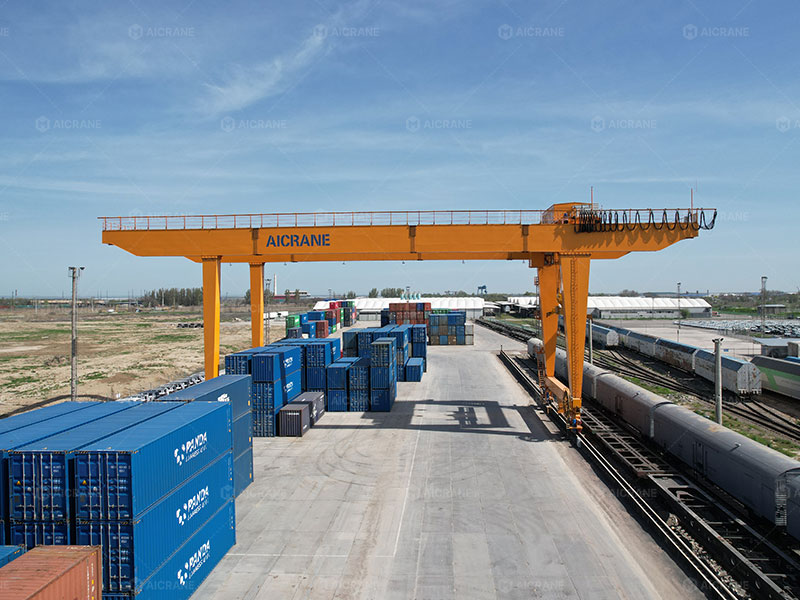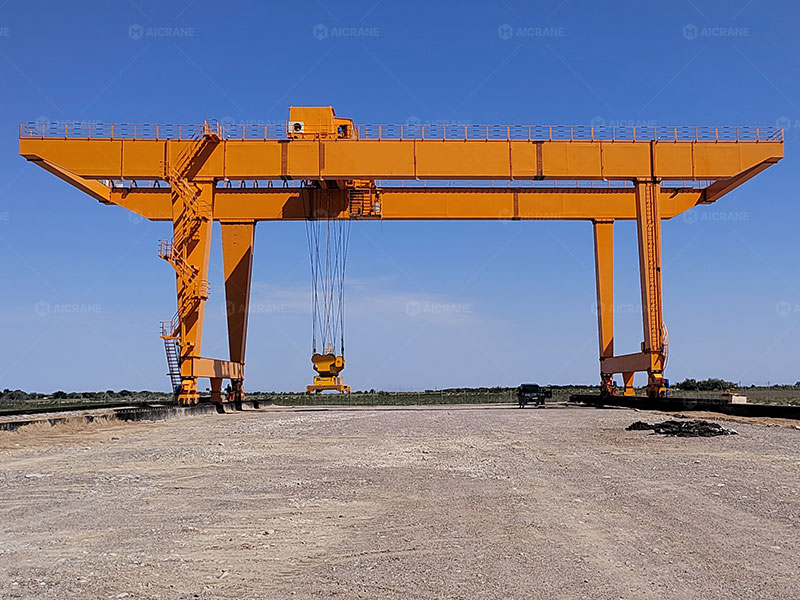Rail Mounted Gantry (RMG) cranes are critical pieces of equipment in container terminals, intermodal yards, and industrial facilities where high precision, automation, and efficiency are paramount. As the demand for fast and reliable material handling increases, the integration of Programmable Logic Controllers (PLCs) into RMG cranes has become a key technological advancement. PLC-based control systems enhance precision, safety, and operational intelligence, allowing RMG cranes to perform complex handling tasks with minimal human intervention.
This article explores how PLC control systems are integrated into RMG cranes, their role in ensuring precision operation, and the benefits they bring to modern container handling operations.

Understanding PLC Control Systems in RMG Cranes
A Programmable Logic Controller (PLC) is a digital computer designed for automation and control of electromechanical processes. In the context of RMG cranes, the PLC acts as the central brain, processing sensor data, executing control commands, and coordinating subsystems such as hoisting, trolley travel, and gantry movement.
PLC systems are highly reliable and designed to function in harsh environments, making them ideal for cranes that operate outdoors and are exposed to varying weather conditions. Modern PLCs are equipped with high-speed processors, modular I/O configurations, and real-time communication capabilities, allowing them to efficiently manage multiple control tasks simultaneously.
The Role of PLC in RMG Crane Operation
PLC systems in RMG cranes are responsible for controlling all major operational movements and ensuring synchronization between subsystems. Their main functions include:
-
Hoisting Mechanism Control:
The PLC manages the lifting and lowering of containers with precise speed and positioning. It adjusts motor speeds using Variable Frequency Drives (VFDs) and monitors feedback from encoders and limit switches to prevent over-travel or sudden load shifts. -
Trolley Travel Control:
The PLC coordinates the horizontal movement of the trolley along the crane’s girders. Position sensors, encoders, and laser alignment systems feed real-time data to the PLC, ensuring that the trolley moves smoothly and stops accurately at designated positions. -
Gantry Travel Control:
The PLC synchronizes the travel motors of both legs of the gantry to maintain alignment and prevent skewing. This synchronization is crucial for rail mounted container gantry cranes where misalignment can cause wheel flange wear or even derailment. -
Load Anti-Sway Control:
PLCs integrate anti-sway algorithms that dynamically adjust motion commands to counteract load oscillations. This improves precision during container positioning and reduces cycle time. -
Safety Monitoring and Interlocks:
Safety features such as overload protection, collision avoidance, emergency stop systems, and interlocks are all managed by the PLC. It continuously monitors operating conditions and activates alarms or shutdowns when unsafe conditions are detected. -
Communication and Data Logging:
The PLC interfaces with Human-Machine Interfaces (HMIs), Supervisory Control and Data Acquisition (SCADA) systems, and remote monitoring platforms to provide operators and managers with real-time data on crane performance and status.
Integration of PLC Systems in RMG Crane Design
Integrating a PLC system into an RMG crane involves both hardware and software considerations.
Hardware Integration
The PLC system is typically installed inside a control cabinet located on the crane. The hardware setup includes:
-
Central Processing Unit (CPU): Executes logic control and processes sensor data.
-
Input/Output Modules: Connect field devices such as limit switches, encoders, and sensors to the PLC.
-
Communication Modules: Enable data exchange between the PLC, drives, and higher-level systems.
-
Power Supply Units: Provide stable DC power for the PLC system and its peripherals.
Wiring between sensors, actuators, and PLC modules must be carefully designed to minimize signal interference and ensure reliability under vibration and temperature variations.
Software Integration
PLC programming defines how the crane operates. Engineers use programming environments such as Siemens TIA Portal or Allen-Bradley Studio 5000 to write control logic using ladder diagrams or function block diagrams. The control software includes:
-
Motion control algorithms for hoisting, trolley, and gantry movement.
-
Logic for synchronization and interlocking.
-
Diagnostic and fault-handling routines.
-
Communication protocols such as PROFINET, EtherCAT, or Modbus TCP for system integration.

Precision Operation Enabled by PLC Control
Precision operation is essential in container handling, where containers must be accurately placed within tight tolerances. PLC systems contribute to this precision in several ways:
Real-Time Sensor Feedback
PLCs continuously process input signals from encoders, limit switches, and laser sensors. This feedback allows the system to fine-tune motor control in real time, resulting in smooth acceleration, deceleration, and accurate stopping.
Closed-Loop Motion Control
With closed-loop control, the PLC monitors the difference between desired and actual positions and makes real-time adjustments. This eliminates drift and compensates for load variations or external disturbances such as wind.
Anti-Sway Control Algorithms
PLC-based anti-sway systems analyze the pendulum motion of the suspended load and adjust speed commands to dampen oscillation. This ensures the container is positioned precisely over the target location, even during high-speed operations.
Synchronization of Movements
In large gantry cranes, both sides of the gantry must move synchronously. The PLC coordinates the motors through a master-slave configuration to maintain perfect alignment. This synchronization enhances mechanical stability and prevents structural stress.
Adaptive Speed and Torque Control
By integrating with frequency inverters, the PLC adjusts motor torque and speed based on load weight and travel distance. This adaptive control improves efficiency and minimizes wear on mechanical components.
Advantages of PLC-Controlled RMG Cranes
Integrating PLC systems into RMG cranes provides numerous operational advantages:
-
Enhanced Precision and Repeatability:
PLCs ensure consistent, accurate movements, crucial for stacking containers in narrow spaces or aligning them on railcars. -
Improved Safety:
Real-time monitoring of load conditions and travel limits helps prevent accidents and equipment damage. -
Higher Efficiency:
Automated cycle optimization and anti-sway features reduce handling time and improve yard throughput. -
Remote Diagnostics and Predictive Maintenance:
PLCs collect operational data that can be analyzed to predict maintenance needs, reducing downtime. -
Scalability and Flexibility:
PLC systems can be easily upgraded or expanded with new modules to accommodate additional sensors or automation features. -
Energy Efficiency:
Through intelligent motor control and regenerative braking, PLCs contribute to reducing energy consumption in RMG operations.
Future Trends in PLC-Controlled RMG Cranes
The next generation of RMG cranes is moving toward smart automation and AI-assisted control. PLCs are increasingly integrated with Industrial Internet of Things (IIoT) platforms, enabling:
-
Cloud-based monitoring for centralized fleet management.
-
Machine learning algorithms that optimize operation cycles and maintenance schedules.
-
Remote operation and digital twins for simulation and performance optimization.
These advancements are transforming traditional RMG cranes into intelligent handling systems that combine reliability, precision, and data-driven decision-making.
Conclusion
The integration of PLC control systems has revolutionized the way RMG cranes operate. By combining high-speed computation, real-time feedback, and intelligent motion control, PLCs ensure that every lift, travel, and positioning operation is executed with unmatched precision.
For container terminals, rail yards, and industrial facilities aiming to enhance efficiency and safety, adopting PLC-based RMG cranes represents a crucial step toward automation excellence. As technology evolves, PLC integration will continue to be the foundation for smarter, safer, and more efficient gantry crane systems that define the future of material handling.